|
|
One
Single, Perfect Day
By
Bill E. Branscum ©2001
Here at our house, my children and I close each day with
a meeting where we discuss plans, dreams, needs, wants
and anything else we have on our minds. Attendance and
participation is not some regimented requirement - it's
an opportunity for everyone that we all enjoy. I find
it especially useful as it allows me to keep a finger
on the family pulse, and acknowledge good behavior and
personal accomplishments. I believe that it is far more
important, and effective, to recognize and reward the
behaviors in our children that we wish to encourage, than
bashing and berating them for their mistakes.
During a recent meeting, it occurred to me that my five
year old son Ryan had been honest with me for quite some
time. It's hard for little children to tell the truth
- sometimes, it can be virtually impossible. Although
Ryan is not the oldest of my little guys, he was the first
to recognize that honesty, in our home, is always the
easiest way out of trouble.
I really did not know precisely when Ryan had last lied
to me but, allowing myself a certain degree of artistic
license (parenting is an art form), I announced during
our meeting that it had been exactly a year. Think about
that from the perspective of my children - "I wonder
what else Dear Old Dad is keeping track of?"
I informed my children that Ryan and I were going to
do something special in recognition of that anniversary
- just he and I together. When I said that Ryan and I
would be hitting the road at 4:00 AM, it was clear that
my children thought that I had "lost it," but
I assured everyone that I had a wonderful plan.
|
| We actually left Naples a little behind schedule
at 4:30 that morning. As we hit the Interstate, the night
air was just a little warm, the exact temperature God meant
for convertibles. Within minutes, we were cruising eastbound
in the Mr. Mom Mobile (see plate) on that isolated stretch
of interstate highway between Naples and Fort Lauderdale -
more commonly known as "Alligator Alley." |
 |
|
Alligator Alley is the seventy mile stretch of asphalt
that traverses the Everglades. It is an uncommon section
of Interstate in that there is nothing there except an off-ramp
at US 29, and another at the Indian Reservation as you are
approaching the Fort Lauderdale side. As desolate as it
is, it is certainly much better than it used to be up until
a few years ago when it was a poorly maintained two lane
road - until recently, there wasn't even a rest area.
It was a crisp, clear night. Within minutes the glow from
the lights of Miami could be seen on the horizon a few points
south of the distinctly separate glow generated by the City
of Fort Lauderdale. Driving across the Alley through the
Everglades at that time of night with no traffic, and no
noise but the rhythmic drone of a high performance engine
and the whistle of the wind, reminded me of what it used
to be like to run "go-fast" boats down the Intracoastal
Waterway. That was "once upon a time," in the
hey day of SW Florida drug smuggling when there were no
speed limits and few idle speed zones.
I had expected him to sleep in the car but he was wide
awake. It was obvious that Ryan was excited to see what
I had planned. It was a pleasant drive, with wonderful company
and there was no, "are we there yet" in our conversation.
In actuality, we were on our way to what may be one of
the most common of all events - a sunrise in Fort Lauderdale.
While I suppose it may seem a bit odd to drive all the way
across the state to see the sun come up, sunrise is spectacular
from the beach as the colors break the horizon and spill
over the water. It never seems to look exactly the same
way twice and I don't think I could ever get tired of seeing
it even if it did.
By 6:15 AM, we were on the beach in Fort Lauderdale. With
civil twilight a half hour away, I had just enough time
to unpack the blanket, thermos and cups I had brought.
"Civil twilight" is a term common to aviators
and navigators. It refers to the time when the sun is positioned
precisely six degrees below the horizon and begins to light
the day. It is a wonderful time to sit on an empty beach
with a friend.
I had tried to think of everything - I truly believe the
glory of any undertaking is in the details. After outlining
the options, I served up homemade hot cocoa with honey while
I opted for the gourmet Hawaiian coffee with a splash of
Kahlua.
The diffuse glow on horizon found us on a lonely beach
in Fort Lauderdale (at the end of 17th), close and comfortable
on a blanket, enjoying each other's company, sipping warm
drinks and crunching on those ridiculously expensive European
finger cookies I hate to admit that I like.
In anticipation of sunrise, the world got brighter and
we could see the things around us. Surprisingly, there were
very few people on the beach. I suppose the most spectacular
of events can grow to become mundane for those who see them
everyday. Perhaps it's not worth it to the locals to get
up that early or it may be that most people are so busy
trudging through lives they are not all that happy with,
that they don't take the time to see what goes on around
them. I don't know, but to me it was worth the trip.
|
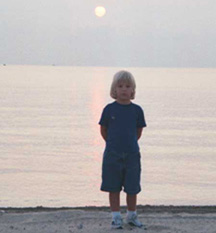 |
 |
|
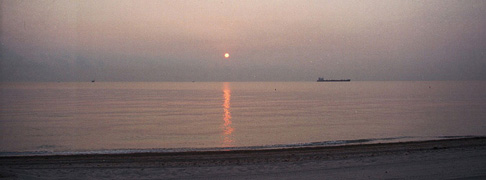
By 7:15 AM, the sun was up, the show was over and the world
around us seemed to wake, move around and begin to make
noise. We returned to the car and drove to have breakfast
as we had a little time to kill.
By 9:30 AM we were on the road again, southbound on the
old coast highway toward Key West. That was not to be our
first stop though.
First, I thought I would try to share with my son a remarkable
testimonial to love that you don't have to be an adult,
or even a little bit of a romantic to appreciate. We were
headed to the Coral Castle, about 25 miles south of Miami
on US Hwy. 1 at 28655 S. Dixie Highway, Homestead, FL.
|
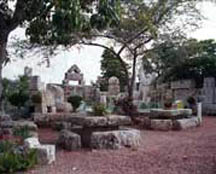 |
It's a peculiar story, especially if you keep
in mind that it isn't some fairy tale or script for a screen
play. Sometimes, I think we all become so accustomed to TV
and film that we lose track of the fact that other people
are real, with hopes, dreams and ambitions just like we have.
It is awfully easy to begin thinking of everyone else as bit
part actors in the play that is our life. TV has taught us
that everything in life takes 60 minutes to create or resolve. |
|
In 1923, a Latvian immigrant named Edward Leedskalnin came
to this country after being spurned on the eve of his marriage
by his betrothed, Agnus Scuffs, whom he thereafter referred
to as his "Sweet 16." Ed, who was 26 years old
at the time, was devastated by her rejection and he spent
the next twenty years of his life building a testimonial
to his love. Through his rather incredible labors, he has
seen to it that Ms. Scuffs will be remembered forever.
Initially known as Rock Gate Park, due to what might arguably
be called it's principal attraction, it is now the Coral
Castle. Whatever you call it, the Coral Castle demonstrates
what one man could do in secret, and all by himself, when
driven by emotion.
|
|
The entrance to the Coral Castle is a rock gate weighing
nine tons that is so delicately balanced that a child can
open it. It is a masterpiece of engineering often, but in
my view unfairly, compared to the Pyramids and Stonehenge.
This man's solitary work has baffled scientists for generations
and created speculations ranging from sorcery to alien intervention.
Why do I say unfairly? How can you compare the work of
a single man, accomplished in utter secrecy, to the work
of an entire cultural society? There is no record that any
human being ever saw Ed Leedskalnin build anything at all.
When you see what he did, the concept defies imagination.
|
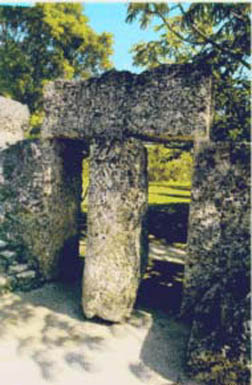 |
|
The reality of this feat is all the more remarkable when
you factor in Leedskalnin's size. Ed Leedskalnin was a diminutive
man standing five feet tall, weighing 100 pounds and it
has been reported that he suffered from tuberculosis.
Ed was a truly remarkable engineer although he claimed
nothing more than a fourth grade education. When asked how
he accomplished his marvel of coral construction, he claimed
to "understand the principles of weight and leverage."
Considering that coral weighs about 125 pounds per cubic
foot and the walls surrounding the castle are constructed
of sections eight feet high, four feet long and three feet
thick, one wonders how this little man moved 13,000 pounds.
|
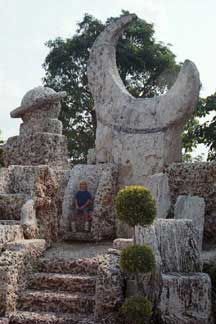 |
 |
| Leedskalnin furnished and appointed his home
with coral structures I could not begin to adequately describe.
The barbecue (upper left), the telescope (upper right), the
heart shaped table (lower left) and the throne (lower right)
are just a few examples. |
 |
 |
|
His story, and labors, ultimately ended in December 1951
when Ed Leedskalnin died in his sleep. He was 64 years old
at the time.
I find myself wondering what ultimately became of his "Sweet
Sixteen." I wonder if Ms. Agnus Scuffs ever realized
how much Edward Leedskalnin adored her, or ever knew about
the remarkable romantic achievement to which he dedicated
his life. Most of all, I wonder if she was really something
special, or if time and emotion created something special
of an ordinary girl in Ed Leedskalnin's mind.
Personally, I find it interesting that Agnus Scuffs is
rarely identified by name, as if her significance as a human
being is an irrelevant aside to the image of "Sweet
16" as she existed for Edward Leedskalnin.
We had a great time there, and we talked about the history
of the place a little, but I think Ryan may not have truly
appreciated the underlying drama behind all that coral sculpture.
I got the distinct impression that I was conveying a bit
more information than he felt like he needed. At any rate,
we were both much impressed, especially with the heart shaped
table.
It was getting late in the afternoon so we had to hurry
in order to follow my plan. Once again, we headed south
on US Hwy. 1 toward Key West, the perennial hangout of Ernest
Hemingway about 160 miles away. It's ironic, or so it seemed
to me, that just as Leedskalnin labored to memorialize his
"Sweet Sixteen," Ernest Hemingway is reported
to have written, A Farewell to Arms in memory the
nurse that cared for him, saved his leg, loved him and rather
brutally dumped him - her name was Agnes too.
As we cruised south to, and through, the Keys, we certainly
followed a much different path than Ponce de Leon and Antonio
de Herrera did when they set sail in search of the illusive
Fountain of Youth and discovered Key West. Their day was
Sunday, May 15, 1513; our Sunday was almost 500 years later.
|
 |
As we left mainland Florida and cruised into Key Largo,
the first of the Florida Keys, Key West seemed like a long
way ahead. With the underwater John Pennekamp Coral Reef
State Park, the Florida Keys National Marine Sanctuary,
the crystal clear water at Molasses Reef, and the caves
of French Reef close at-hand, Key Largo is known as the
Diving Capital of the World.
Key Largo also is home to the genuine, original steamship
"African Queen," as featured in the Bogart movie,
as well as the Florida Keys Wild Bird Center and the Key
Largo State Botanical Site. Tavernier, on the southern end
of Key Largo, is a quaint settlement that boasts some of
the oldest structures in the Keys
|
|
Once we passed through Tavernier, the highway began a long,
slow curve in a westerly direction as it took us through
Plantation Key and Islamorada. Islamorada gets it's name
from the fact that it has a purplish appearance from a distance
- the Spanish explorers called it the "purple isle"
(isla morada). Just as Key Largo claims to be the diving
capital of the world, Islamorada claims to be the "fishing
capital of the world."
As we headed south from Islamorada on the Florida Keys
Overseas Highway, a series of 42 bridges that carried us
from key to key, our next major stop was Marathon. Marathon
boasts the conveniences of a modern community including
a hospital, shopping plazas and the only commercial airport
between Key West and the mainland, but it retains the charm
of its roots as a 19th-century fishing village.
|
|
Seven Mile Bridge, which begins just south of Marathon
Key and runs to Bahia Honda, is reputed to be the longest
segmented bridge in the world. I don't know about that,
but it is certainly a dream to drive across on a beautiful
day in a convertible.
The end of Seven Mile Bridge marks the beginning of the
area known as the Lower Keys.
|
 |
| As you begin the trek southwestward toward Big
Pine Key, you've come about two-thirds of the way. As you
can see from the map, it's a long stretch of water to drive
across. |
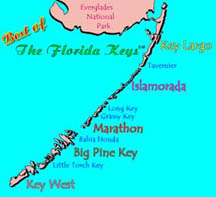 |
The Lower Keys were sparsely settled in the early to mid
1800's. Mosquitoes and the lack of any particular way of
making a living made it difficult to homestead this area
but a few pineapple farms flourished and a large pineapple
factory was built which furnished canned pineapple to most
of eastern North America.
During this time period, Key West had a population of 18,000,
making it the largest city in Florida. A playground for
the rich, it was also the most affluent city in America.
|
|
In 1912, Henry Flagler completed his Overseas Railroad
making it possible to settle the Lower Keys. The train ran
from its completion in 1912 until 1935 when the great Labor
Day hurricane destroyed it. The railroad left many remnants
of its existence in the Lower Keys. Water towers, sumps,
sinkholes and sections of the railway bridges are still
evident.
Big Pine Key was once the site of a shark processing factory
that employed workers to catch sharks and skin them. The
hides were salted down and sent north to the home factory
in New Jersey where they were processed into a tough leather
called shagreen.
As we cruised south through Big Pine Key, Summerland Key,
the Big Torch and Little Torch Keys, Cudjoe Key, Sugarloaf
Key and Big Coppitt Key, Key West got closer and closer.
|
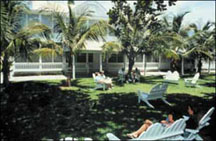 |
 |
|
Key West, the home of the Little White House and the Hemingway
House is a collection of tourist attractions but they were
not the reason we had come. We came to see Mallory Square,
the world famous center of Key West's waterfront best known
for it's Sunset Celebration. There's nothing going on there
until sundown though - we came to see the town.
|
| Our first stop was Ripley's Believe it or Not
on Duval Street. As you walk in past the two-headed calf,
you know it's no ordinary place. I had never been to Ripleys,
so I didn't know what to expect - I was impressed but parents
might want to review the place before taking young children.
Nothing there bothered Ryan though. |
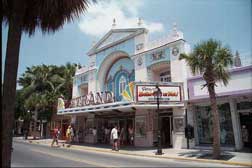 |
|
As we walked down Duval Street, Ryan and I encountered
a scene common to all old city neighborhoods. One of the
local drunks apparently took exception to something a police
officer said or did and his semi-coherent ravings created
something of a spectacle. Ryan was not entirely sure what
to make of it and, whatever happened, I knew it would give
us something to talk about so we stood by and watched.
Officer Bradford was a really tall guy - I guess when you're
that big you must be careful whacking on people even when
they really need it. Although it would have suited me just
fine to have Ryan learn that adults can be spanked too,
the officer was patient beyond patient and Ryan got a great
lesson in self control. Whatever the Key West PD is paying,
it isn't enough.
After dealing with Baron von Barroom, the Lord of Libation
and Heir Apparent to the Porcelain Throne, the officer shuffled
around in his car a minute and walked over to talk to Ryan.
Ryan isn't scared of policemen but this gentleman is uncommonly
tall; I could tell Ryan was just a wee bit uncertain he
wanted to talk to him.
|
 |
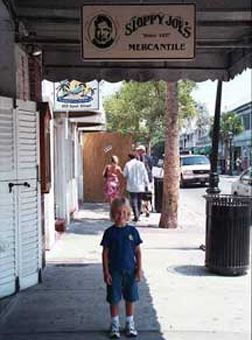 |
|
It was a solemn event; I certainly was impressed at the
gravity of Officer Bradford's demeanor as he swore Ryan
in. Ryan promised not to get involved with drugs, disobey
his parents, smoke cigarettes and various other things -
before I knew it, Ryan was sworn in and wearing a badge.
Off we went to celebrate and where better than Sloppy Joe's
Bar?!
I was surprised to see the price list - since Sloppy Joe's
is known as the place Hemingway liked to hang out, and the
one bar anyone is likely to be able to name in Key West,
I expected a tourist trap. The prices were reasonable, the
service was great, the chicken strips were as good as any
we'd had and, unlike "Billie's" down the street,
they didn't charge me for another drink every time Ryan
needed his cup refilled. It was a great place to relax until
sundown.
|
|
The Sunset Celebration is a daily event of spontaneous
entertainment provided by street performers. In an unchoreographed,
disorganized, display of talent and curiosities, these artists
create an atmosphere akin to that of Bourbon Street.
|
 |
 |
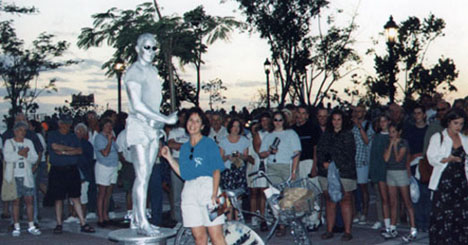 |
| On any night of the year, those who come to
Mallory Square a couple of hours before sunset find; jugglers,
tight rope walkers, trained animals, fire eaters, escape artists,
singers, human statues and a variety of other performances
calculated to amuse and enchant them. |
 |
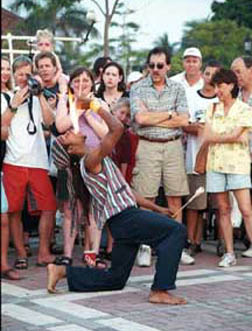 |
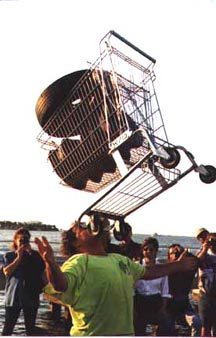 |
 |
| There is no charge and there are no tickets;
the talented perform for the sake of performance and the crowds
contribute tips to the extent that they feel is justified
and appropriate (or they are supposed to). It's an incredible
spectacle of entertainment gone completely out of control. |
 |
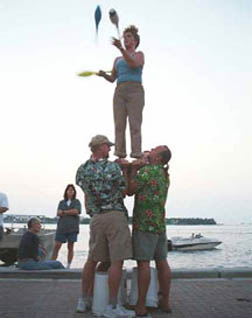 |
|
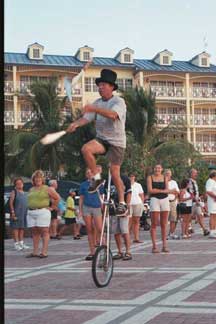
|
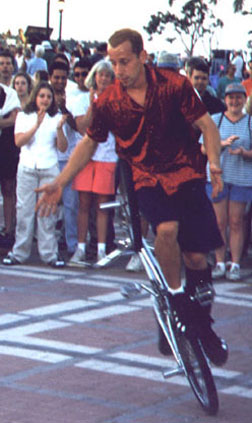
|
|
There was so much to see; the performers were all very
considerate of one another (and the crowds) by waiting until
one artist was finished before another began their act.
It was entertaining, for young and old alike - it was sad
that so many people watched the acts, and walked away when
the performers "passed the hat."
Ryan and I talked about that a bit. I think parents should
talk with their children - not talk at them but really talk
to them and exchange some thoughts. I found it particularly
rewarding to listen to what Ryan said, and see how his five
year old mind worked. I don't think it would have occurred
to him had I not brought the issue up, but once I mentioned
it, he didn't think it was fair for people to watch acts
they couldn't, or wouldn't, pay for.
I don't try to tell my children what to think, I see no
point in that. We watched the performers, and the crowds
and lessons were learned from both. I gave him a handful
of dollar bills and left it to him what he should pay, and
to whom.
At a little distance, I stood and watched my son as he
marveled at the magic he saw. With each performance, he
was enthralled as only a child can be. I also saw him watch
people as they walked away, and I could see that he thinking
about the things we discussed and was proud to contribute
his money, and pay his share.
The thing I found most fascinating was Ryan's decision
when his money ran out. He was down to his last two dollars
as he watched the man on the unicycle and it was clear he
really enjoyed the show. "The Immigrant," as he
called himself, was funny, clever, talented and loud - it
was a really good performance. Although Ryan had given most
of the other performers two dollars, and some of those that
weren't as impressive just one, I expected him to give the
cyclist a single dollar so he could have money left to pay
to watch another act.
Instead, Ryan gave him his last two dollars and then walked
over and thanked me for bringing him. I wish I could share
with you that feeling as we walked to the dock to see the
sun go down, as I held the hand of my five year old, knowing
he will one day grow up to be the kind of man I will be
proud of. Does life get any better than that?
|
 |
|
As we sat together and watched the sun set, bringing our
day to a close, I thought about the first time I had recognized
that a state with east and west coasts offered a unique
opportunity to see the sun rise, and set, over the water.
It was a troubled time for all of us back then, and I thought
I saw in this a marvelous potential.
There are times in life that things can become so terribly
messed up that the effort to forgive and forget is self
defeating, serving only to dredge up that which must be
left forgotten. It seemed to me that the salvation of our
relationship depended upon putting the past behind us, and
setting out together again, resolute in joint agreement
never to look back. How, exactly, do you do that; how do
you clear the decks, close the books and start with a clean
slate?
I didn't know, but I thought about it a lot back then,
and it occurred to me that two people who desperately needed
a new start, and a fresh beginning, might set out on a personal
pilgrimage to witness the dawning of their first day together
on a lonely beach, inviting the rising sun to pierce our
personal gloom and wash away the darkness in our lives,
just as it had for all the world since the beginning of
time.
I visualized a dramatic fresh start, a new day, where we
might follow the sun across the sky, discovering one another
again against the backdrop of a wonderfully romantic experience,
celebrating our promise and potential, until we arrived
upon another beach, on another coast, and put our day to
bed. With so much at stake, it seemed to me that if it was
important enough, if we wanted it badly enough, we might
thus create our own special day, resolved that it would
be a foundation for our future and serve to set the standard
for every day to come. I cannot say if it would have worked
or not; I can't say that we tried.
This particular trip marked no effort to resurrect a relationship;
instead, it served to cement one, strengthen it and underscore
the importance of honesty within our family. Honesty is
so important in all relationships.
I hope you enjoyed sharing our little trip with us. It
was a truly memorable event between father and son - One
Single, Perfect Day.
|
|
|





